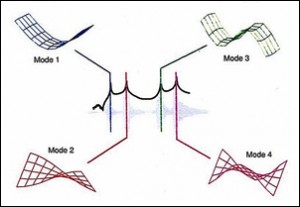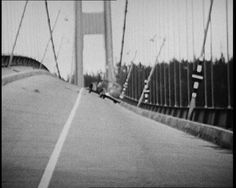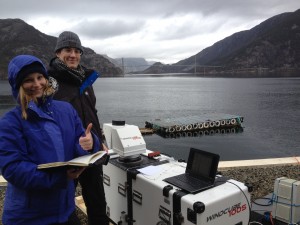Winds are one of the strongest environmental forces. Hurricanes, for example, lead to massive area wide destruction, leaving families without their homes. However, winds can not only be harmful if they reach hurricane force. Similar to the wolf in three little pigs, winds can also destroy structures if they huff or puff in the right frequency to trigger resonance. As you can see in the video, a wind speed of around 18 m/s was enough to lead the old Tacoma Narrows Bridge in Washington into a total collapse. To answer the question how this could happen, we need to understand what the natural frequency of a structure is and how it is linked to resonance.
Let’s imagine the wind pushes a bridge like the mum pushes her kid on the swing. She will start pushing to swing her kid, but if she continues to push at the right time, the swing gets higher and higher, which leads to a happily screaming kid or a swinging bridge sentenced to collapse. The right timing refers to the natural frequency of the swing. Actually, every thing in the world has a natural frequency, meaning that it could swing, vibrate or oscillate without an applied force. If we however apply a force to a structure with a frequency equal to the natural frequency, the amplitude of the oscillation will increase dramatically. The structure vibrates stronger and stronger, which is called resonance.

Figure 2: Illustration of different oscillation modes, which correspond to different natural frequencies. Follow this link to see an example of different movements of a wooden suspension bridge.
Bridges can theoretically swing in different ways. It is similar with a plastic panel; you can band it, twist it or do both at the same time (figure 2). Dependent on the different movement possibilities and the complexity of the structure, bridges can also have several different natural frequencies. More than one natural frequency not only increases the risk of resonance but also the complexity of movements the structure or the material has to withstand.
Now we could ask our selves why not all bridges in the world swing. The answer lies in how clever engineers design bridges. With their knowledge and the help of new materials the Tacoma Narrows Bridge accident did not reoccur. After designing a bridge, engineers are aware of its resonance frequencies. The next challenge is to make sure that these frequencies are not present in wind patterns at the location of later construction. That is why wind measurements play an important role in the planning phase of bridge constructions.
How winds trigger bridge movements is the field of expertise of Jasna Bogunovic Jakobsen, Professor in Offshore Structural Engineering at the University of Stavanger, and topic of her on-going measurement campaign at the Lysefjord Bridge in Norway. To study the wind response of the bridge, she installed several sonic anemometers and accelerometers on and in the bridge. While the former measures high frequency fluctuations of the wind, the latter stores the movements from the bridge. As it is crucial to understand where wind fluctuations are coming from I had the chance to contribute to the study with my LiDAR.
We installed the LiDAR several kilometres southeast of the Lysefjord Bridge, where it measured several horizontal wind cross-sections, covering the fjord entrance (figure 2). With these measurements we want to understand the spatial wind variations and the influence of the local topography. For example, mountain waves can make steady wind patterns to complex non-linear flows.
Now we know how complex the construction of bridges is. Engineers not only have to build their bridges of bricks but they also have to be aware of who else may show up at their construction site. In order to avoid unexpected guests, we have to study local wind patterns and understand their origin.









